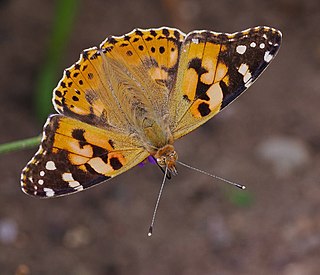
Cynthia is a group of colourful butterfly species that used to be considered a subgenus of the genus Vanessa, in the family Nymphalidae. Before that, it was first described as a genus. Nowadays, this group is not considered a valid taxon anymore, because it is paraphyletic. The name CynthiaFabricius, 1807 is now a junior subjective synonym of VanessaFabricius, 1807.

The West Coast lady is one of three North American species of brush-footed butterflies known colloquially as the "painted ladies". V. annabella occurs throughout much of the western US and southwestern Canada. The other two species are the cosmopolitan Vanessa cardui and the eastern Vanessa virginiensis. This species has also been considered a subspecies of the South American Vanessa carye and is frequently misspelled as "anabella".

The Scotch argus is a butterfly of the family Nymphalidae. In spite of its English name argus, it is not a close relation of the brown argus nor the northern brown argus.

Papilio paris, the Paris peacock swallowtail, is a species of swallowtail butterfly found in the Indian subcontinent and southeast Asia.
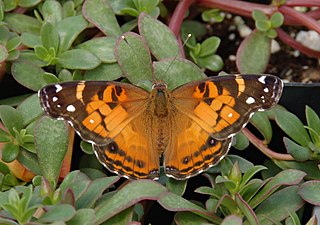
The American painted lady or American lady is a butterfly found throughout North America.

The dryandra moth is a species of moth that is considered to be the sole member of the family Carthaeidae. Its closest relatives are the Saturniidae and it bears a resemblance to many species of that family, bearing prominent eyespots on all wings. The common name is derived from the Dryandra shrubs of the genus Banksia, on which the larva of this species feed, and is hence restricted to the south-west of Western Australia where these shrubs grow. Other Grevillea shrubs may also be used as host plants.

Erebia euryale, the large ringlet, is a species of butterfly belonging to the family Nymphalidae.

Erebia alberganus, the almond ringlet or almond-eyed ringlet, is a butterfly of the family Nymphalidae.

Erebia ligea, the Arran brown, is a member of the subfamily Satyrinae of the family Nymphalidae. This brown is widespread in south-eastern and northern Europe. It prefers mixed woodlands at low altitudes. It is rarely seen in open areas. This species was first described by Carl Linnaeus in his 1758 10th edition of Systema Naturae, and the type locality is Sweden.
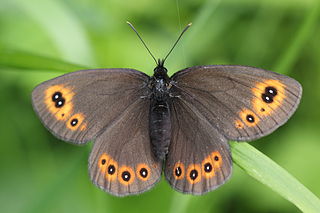
Erebia medusa, the woodland ringlet, is a member of the subfamily Satyrinae of the family Nymphalidae.

Erebia tyndarus, the Swiss brassy ringlet, is a European brush-footed butterfly species of the subfamily Satyrinae.
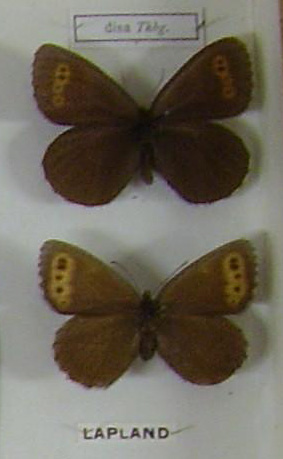
The Arctic ringlet or Disa alpine is a member of the subfamily Satyrinae of family Nymphalidae. It is associated with wet muskeg and bogs in subarctic and Arctic climates, and is often found near the tree-line. The larva overwinters twice before undergoing metamorphosis into an adult. It is found in Arctic Europe, Arctic European Russia, Sajan, Irkutsk, Yakutsk, Yablonoi and Arctic North America.

The black ringlet is a member of the subfamily Satyrinae of the family Nymphalidae. It is a high-altitude butterfly found in Albania, former Yugoslavia, Bulgaria, Greece, and Romania.
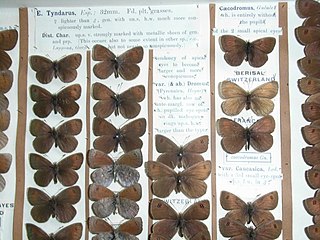
The brassy ringlets are a species group of ringlet butterflies in the genus Erebia. Though closely related, their monophyly is not completely resolved. Still, the brassy ringlets are taxa similar to E. tyndarus – the Swiss brassy ringlet –, and in many cases certainly close relatives. A notable trait of their genus is an ability to adapt well to cold and somewhat arid habitat, like taiga or regions with alpine climate. Optimal habitat in Eurasia, where most of the brassy ringlets are found, therefore occurs in two distinct belts – in the very north of the continent and in the Alpide belt – in interglacials, and in glacials in one periglacialic belt at lower altitude, in places interrupted by dry wasteland and deserts.
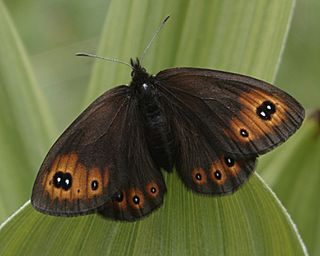
Erebia epipsodea, the common alpine, is a butterfly species of the subfamily Satyrinae of family Nymphalidae. It is found in North America from Alaska south through the Rocky Mountains to northern New Mexico and east across the prairie provinces to southwest Manitoba.

Erebia melampus, the lesser mountain ringlet, is a member of the subfamily Satyrinae of the family Nymphalidae.

Oeneis nevadensis is a species of butterfly in the family Nymphalidae. It is commonly known as the great Arctic, Nevada Arctic, great grayling, Felder's Arctic, or Pacific Arctic. It is native to northwestern North America.
Erebia polaris, the Arctic woodland ringlet, is a butterfly of the family Nymphalidae. It is found in Lapland and boreal Asia.

Erebia rossii, the Arctic alpine or Ross's alpine, is a member of the subfamily Satyrinae of the family Nymphalidae. It is found in Arctic North America and northern Eurasia.
Erebia pawloskii, commonly known as the yellow-dotted alpine, is a member of the subfamily Satyrinae of the family Nymphalidae. It is found in North America in northern British Columbia, Yukon, and Alaska. It is also found in the Sayan Mountains, and from northern Mongolia to Yakutia and Kamchatka. The habitat consists of grassy areas in and above wet tundra, as well as bogs.


















